Bacterial biosensors for in vivo spatiotemporal mapping of root secretion
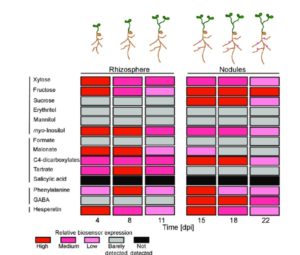 Biosensors are powerful tools that provide readouts for various small molecules so that they can be detected and located. Pini et al. have developed a set of biosensors for expression in bacteria (Rhizobium leguminosarum) that reveal some of the small molecules (including key sugars, polyols, organic acids, amino acids and flavonoids) secreted by the roots of its symbiotic partner pea (Pisum sativum). The authors developed biosensors by fusing the promoter element of a gene specifically expressed by a small molecule to the luciferase reporter lux. Nine of the 14 biosensors only responded to a single compound. The biosensors allowed the authors to spatially and temporally track rhizosphere metabolites during nodulation and to evaluate how different mutant backgrounds affected these metabolites. Plant Physiol.
Biosensors are powerful tools that provide readouts for various small molecules so that they can be detected and located. Pini et al. have developed a set of biosensors for expression in bacteria (Rhizobium leguminosarum) that reveal some of the small molecules (including key sugars, polyols, organic acids, amino acids and flavonoids) secreted by the roots of its symbiotic partner pea (Pisum sativum). The authors developed biosensors by fusing the promoter element of a gene specifically expressed by a small molecule to the luciferase reporter lux. Nine of the 14 biosensors only responded to a single compound. The biosensors allowed the authors to spatially and temporally track rhizosphere metabolites during nodulation and to evaluate how different mutant backgrounds affected these metabolites. Plant Physiol.


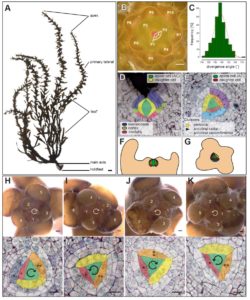 Classic studies of leaf placement (phyllotaxy) showed that two different mechanisms occur in land plants. In mosses, leaf placement is determined by the plane of cell division within the single apical cell, whereas in seed plants auxin acts as a morphogen that specifies leaf positioning. Linardić and Braybrook examined how the spiral pattern of phyllotaxy is determined in the brown alga Sargassum muticum. Although multicellularity arose independently in brown algae and plants, there are similarities in their indeterminate structure and apical meristem-like regions. The authors showed that in the brown alga the spiral orientation of the apical cell cleavage is unlinked to the spiral orientation of phyllotaxy. Destruction of the apical cell was frequently followed by reorganization and re-establishment of phyllotaxy, suggesting that it is a self-organizing principle, but there is no evidence for auxin involvement. BioRxiv
Classic studies of leaf placement (phyllotaxy) showed that two different mechanisms occur in land plants. In mosses, leaf placement is determined by the plane of cell division within the single apical cell, whereas in seed plants auxin acts as a morphogen that specifies leaf positioning. Linardić and Braybrook examined how the spiral pattern of phyllotaxy is determined in the brown alga Sargassum muticum. Although multicellularity arose independently in brown algae and plants, there are similarities in their indeterminate structure and apical meristem-like regions. The authors showed that in the brown alga the spiral orientation of the apical cell cleavage is unlinked to the spiral orientation of phyllotaxy. Destruction of the apical cell was frequently followed by reorganization and re-establishment of phyllotaxy, suggesting that it is a self-organizing principle, but there is no evidence for auxin involvement. BioRxiv 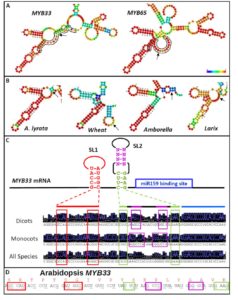 The interactions with microRNAs (miRNAs) and their targets in plants is assumed to be dependent largely on complementarity between the two RNAs. Zheng et al. investigated the interactions between miR159 and its putative targets, mRNA of several MYB genes, each with similar complementarity to the miRNA. Genetic data however suggest that miR159 silences some of these MYB genes more effectively than others. The authors found that the presence of two stem-loop RNA structures adjacent to the miRNA target site enhanced the efficacy of miR159. The authors suggest that the function of the stem-loop structures might be to increase the likelihood of the target site being single-stranded, or might facilitate interactions with proteins that would affect silencing efficacy. These results show that sequence complementarity alone is not sufficient to determine the efficacy of miRNAs, but that flanking sequences and structures are also important. Plant Physiol.
The interactions with microRNAs (miRNAs) and their targets in plants is assumed to be dependent largely on complementarity between the two RNAs. Zheng et al. investigated the interactions between miR159 and its putative targets, mRNA of several MYB genes, each with similar complementarity to the miRNA. Genetic data however suggest that miR159 silences some of these MYB genes more effectively than others. The authors found that the presence of two stem-loop RNA structures adjacent to the miRNA target site enhanced the efficacy of miR159. The authors suggest that the function of the stem-loop structures might be to increase the likelihood of the target site being single-stranded, or might facilitate interactions with proteins that would affect silencing efficacy. These results show that sequence complementarity alone is not sufficient to determine the efficacy of miRNAs, but that flanking sequences and structures are also important. Plant Physiol.  Precise genome editing holds tremendous promise for meeting future food security needs and sustainable agriculture. Čermák et al. describe a set of reagents that facilitate genome editing in plants, based on both TALEN (Transcription Activator-Like Effector Nucleases) and CRISPR/Cas technologies. Precise targeting of enzymes to specific regions of genomes enables many different types of editing. In this paper, the authors describe a “comprehensive, modular system for plant genome engineering that makes it possible to accomplish gene knockouts, replacements, altered transcriptional regulation or multiplexed modification.” Furthermore, these reagents have proven useful in both monocots and dicots. Detailed protocols are available in the Supplemental Information, and a
Precise genome editing holds tremendous promise for meeting future food security needs and sustainable agriculture. Čermák et al. describe a set of reagents that facilitate genome editing in plants, based on both TALEN (Transcription Activator-Like Effector Nucleases) and CRISPR/Cas technologies. Precise targeting of enzymes to specific regions of genomes enables many different types of editing. In this paper, the authors describe a “comprehensive, modular system for plant genome engineering that makes it possible to accomplish gene knockouts, replacements, altered transcriptional regulation or multiplexed modification.” Furthermore, these reagents have proven useful in both monocots and dicots. Detailed protocols are available in the Supplemental Information, and a  While screening for mutants in gene silencing, Ikeda et al. identified mail1, which shows elevated expression of transposable elements (TEs) and protein-coding genes, indicating that MAIL1 (MAINTENANCE OF MERISTEM-LIKE1) is required for epigenetic silencing of some genes. However, mail1 does not differ from wildtype in either DNA methylation or siRNA accumulation, indicating it is involved in a distinct form of gene silencing. DAPI staining showed that pericentromeric regions are decondensed in mail1. MAIL1 has an aminotransferase-like, plant mobile domain that is similar to a DNA-binding domain found in transposases. The function of this domain and whether it originated in a gene or a transposon remain unknown. Nature Comms.
While screening for mutants in gene silencing, Ikeda et al. identified mail1, which shows elevated expression of transposable elements (TEs) and protein-coding genes, indicating that MAIL1 (MAINTENANCE OF MERISTEM-LIKE1) is required for epigenetic silencing of some genes. However, mail1 does not differ from wildtype in either DNA methylation or siRNA accumulation, indicating it is involved in a distinct form of gene silencing. DAPI staining showed that pericentromeric regions are decondensed in mail1. MAIL1 has an aminotransferase-like, plant mobile domain that is similar to a DNA-binding domain found in transposases. The function of this domain and whether it originated in a gene or a transposon remain unknown. Nature Comms.  Sunflower (Helianthus annuus L.) is an important oil crop and, according to the authors, “the only major crop domesticated in North America.” Assembling its genome has been difficult as more than three quarters of it is made up of young (less than one million years old) long-terminal repeat retrotransposons. Badouin et al. report a reference genome for sunflower which they generated from long reads. Their data revealed the evolutionary history of sunflower. Through quantitative genetics, and expression and diversity data, they identified genes and gene networks associated with flowering time and oil production, two important breeding traits. Nature
Sunflower (Helianthus annuus L.) is an important oil crop and, according to the authors, “the only major crop domesticated in North America.” Assembling its genome has been difficult as more than three quarters of it is made up of young (less than one million years old) long-terminal repeat retrotransposons. Badouin et al. report a reference genome for sunflower which they generated from long reads. Their data revealed the evolutionary history of sunflower. Through quantitative genetics, and expression and diversity data, they identified genes and gene networks associated with flowering time and oil production, two important breeding traits. Nature  Pigeonpea (Cajanus cajan) is a widely-grown tropical legume domesticated in India about 3500 years ago. Yields have plateaued, and there is evidence for a genetic bottleneck that limits breeding potential in the elite varieties. Varshney et al. resequenced nearly 300 pigeonpea accessions including modern cultivars, traditional landraces and wild species. From these data they identified more than 17 million variants, including many regions that show evidence of selection during domestication and breeding. Marker-trait associations for flowering time and seed yield also were identified. Nature Genet.
Pigeonpea (Cajanus cajan) is a widely-grown tropical legume domesticated in India about 3500 years ago. Yields have plateaued, and there is evidence for a genetic bottleneck that limits breeding potential in the elite varieties. Varshney et al. resequenced nearly 300 pigeonpea accessions including modern cultivars, traditional landraces and wild species. From these data they identified more than 17 million variants, including many regions that show evidence of selection during domestication and breeding. Marker-trait associations for flowering time and seed yield also were identified. Nature Genet. 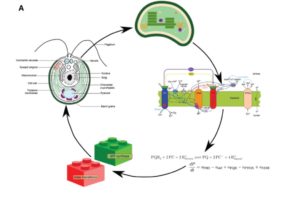 Deriving energy from light is a bit like keeping your hands warm by juggling burning coals; doable but dangerous. Photosynthetic organisms constantly adjust their photosynthetic machinery to optimize energy production but avoid damage from excess light. Moejes et al. describe a large-scale project, AccliPhot, that combined theoretical and experimental approaches to understand photosynthetic acclimation in algae and higher plants. They also describe progress towards using these insights to improve algal culture systems to optimize lipid production for biofuels. J. Exp. Bot.
Deriving energy from light is a bit like keeping your hands warm by juggling burning coals; doable but dangerous. Photosynthetic organisms constantly adjust their photosynthetic machinery to optimize energy production but avoid damage from excess light. Moejes et al. describe a large-scale project, AccliPhot, that combined theoretical and experimental approaches to understand photosynthetic acclimation in algae and higher plants. They also describe progress towards using these insights to improve algal culture systems to optimize lipid production for biofuels. J. Exp. Bot. 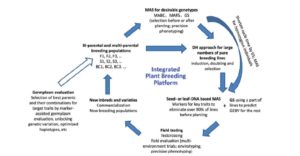 Yield is determined by the crop’s genetic potential and the realization of that potential as affected by agronomic practices and environmental factors. Xu et al. address how yields can be improved through enhancing genetic gain, which they define as “the amount of increase in performance that is achieved annually through artificial selection.” Factors that affect genetic gain include the genetic variance of the population (including variance that can be created as well as contributions from wild relatives), heritability, selection intensity (affected by methods used to assess phenotype and their costs), and cycle time (which can be accelerated through greenhouses and winter nurseries). This review, recommended reading for students, nicely demonstrates how, “Advances in biological science and technology, which involve genomics, informatics, modeling, communication technologies, satellite imaging, remote sensing, and precision farming and agriculture, have contributed significantly to increasing crop productivity.” J. Exp. Bot.
Yield is determined by the crop’s genetic potential and the realization of that potential as affected by agronomic practices and environmental factors. Xu et al. address how yields can be improved through enhancing genetic gain, which they define as “the amount of increase in performance that is achieved annually through artificial selection.” Factors that affect genetic gain include the genetic variance of the population (including variance that can be created as well as contributions from wild relatives), heritability, selection intensity (affected by methods used to assess phenotype and their costs), and cycle time (which can be accelerated through greenhouses and winter nurseries). This review, recommended reading for students, nicely demonstrates how, “Advances in biological science and technology, which involve genomics, informatics, modeling, communication technologies, satellite imaging, remote sensing, and precision farming and agriculture, have contributed significantly to increasing crop productivity.” J. Exp. Bot.